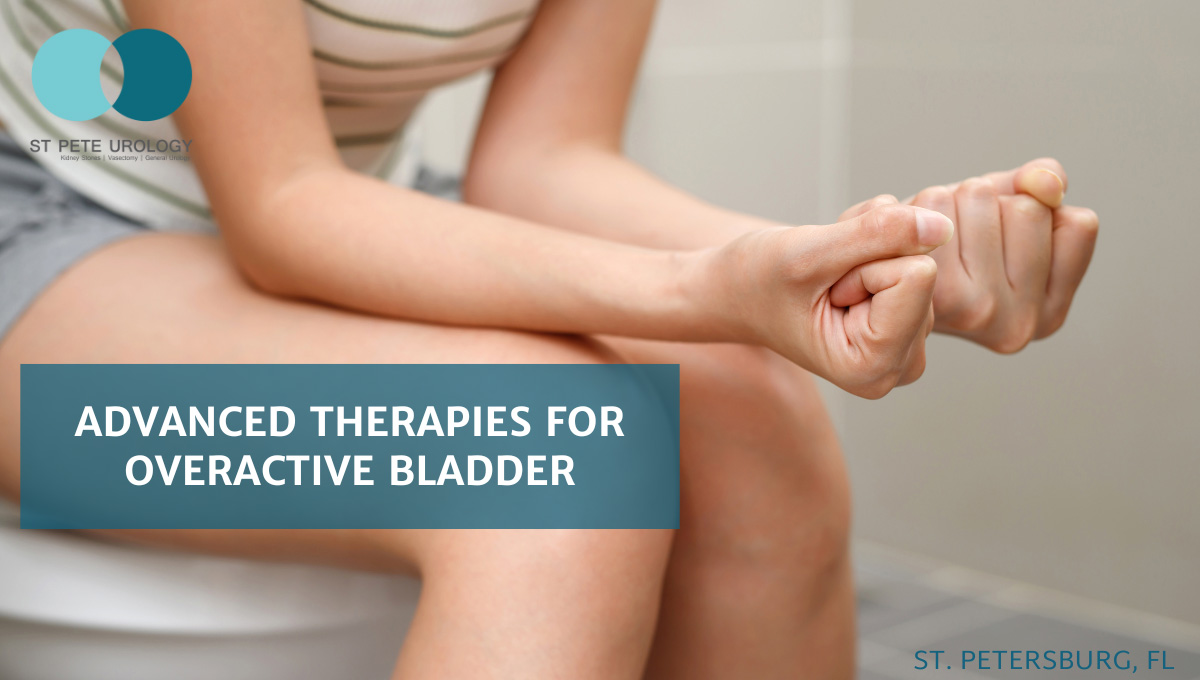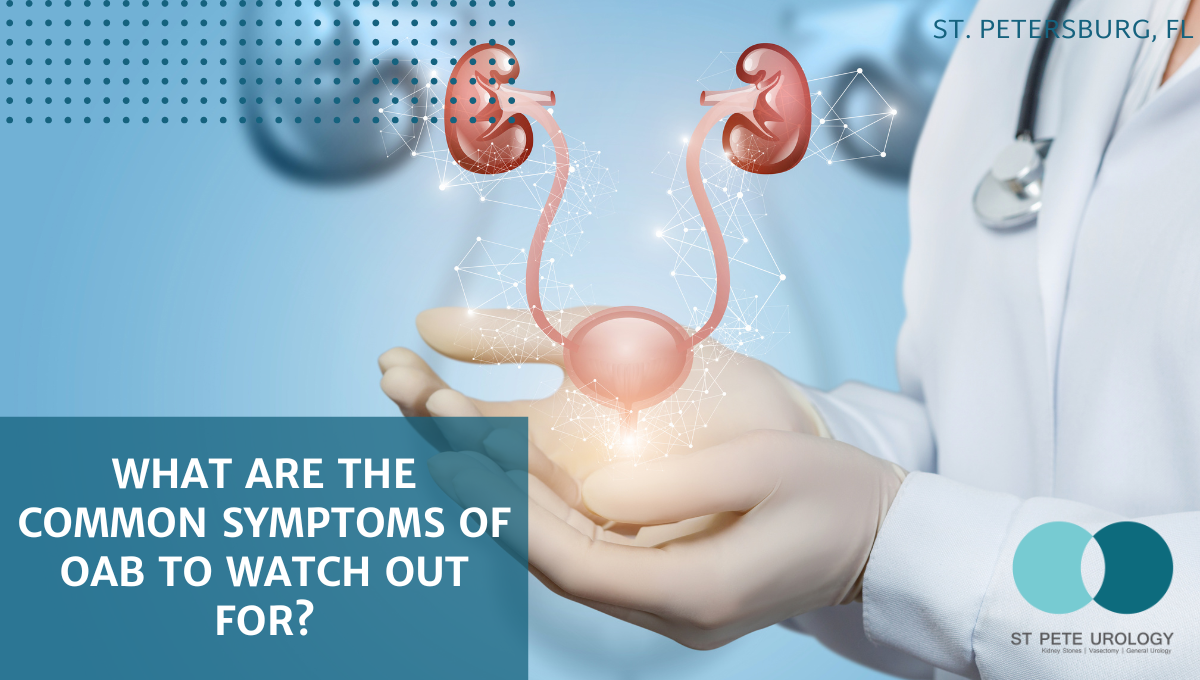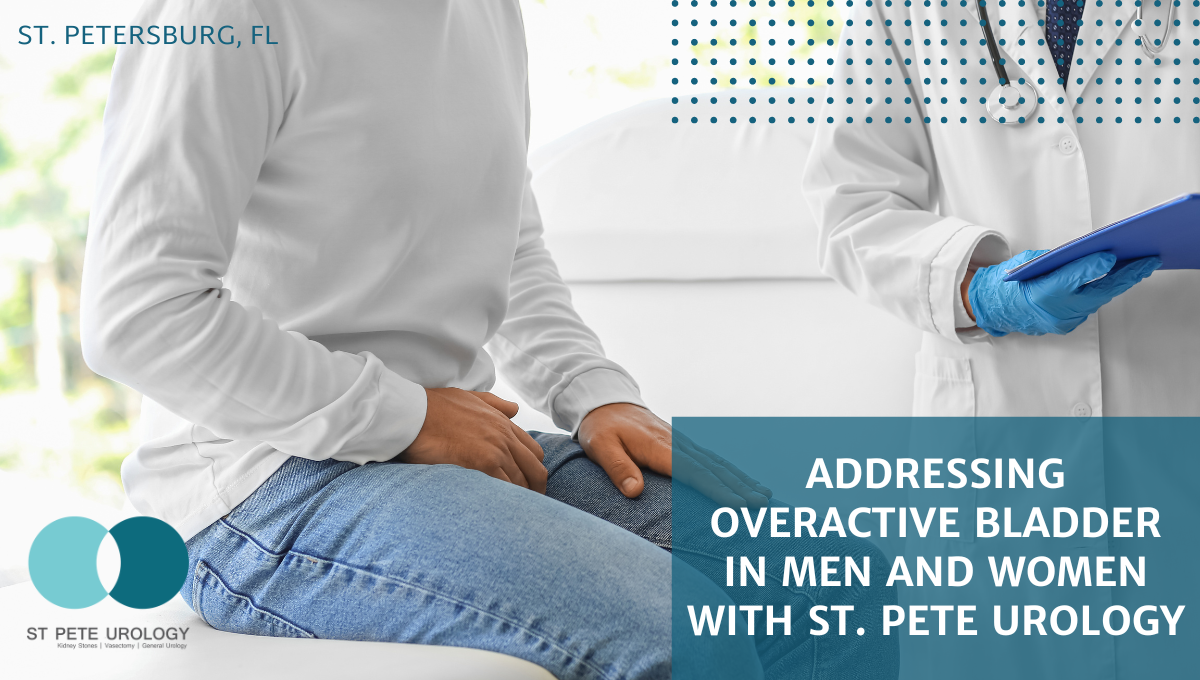Advanced therapies for overactive bladder include the Medtronic InterStim System, Botox injections and more. Learn more here at St Pete Urology.
Continue readingDifferent Treatment Options for Overactive Bladder
Understanding the different treatment options for overactive bladder will lead to a more accurate and personalized treatment plan.
Continue readingHow to Find the Best Urologist for OAB Near You?
Key Takeaways:
- Start your search for the best urologist for OAB with research and patient reviews and testimonials.
- Look for a urologist who offers advanced diagnostic and treatment options and a patient-centered approach.
- Ensure the urologist accepts your insurance and inquire about costs, co-payments, and deductibles.
You. Yes, you with the recurring restroom visits, who has Overactive Bladder (OAB) written in the margins of your life. Understandably, you’re more than ready to find the right urologist for OAB near you. Because, let’s face it, this isn’t just about a healthcare provider; it’s about changing your life.

Introduction: Identifying OAB and Finding the Best Urologist
OAB is a condition marked by an uncontrollable urge to urinate, often accompanied by incontinence, nocturia, and frequency. It’s more than an inconvenience. It’s an unwelcome thief, stealing away your peace of mind. But with the right urologist, it’s treatable.
Researching Urologists in Your Area: Starting From the Right Point
Pinning down the right urologist starts with a healthy dose of research. Turn to the digital realm, leverage online search platforms and directories. “Urologist for OAB Near Me” should be your mantra. Don’t be shy about asking your primary care physician for recommendations. They’re in the industry and their advice can be invaluable. But remember, patient reviews and testimonials should be your compass.
Evaluating Urologists for OAB Treatment: Going Beyond the Surface
Beyond credentials and board certification, which frankly should be the minimum requirement, look for urologists with experience and specialization in OAB. Progressive urologists offering advanced diagnostic and treatment options are a plus. But remember, the most important factor should be a patient-centered approach – a urologist who talks with you, not at you.
Scheduling Initial Consultations: Making the First Move
Once you’ve narrowed down potential urologists, make that call. During consultations, ask about their approach towards managing OAB. Are conservative approaches, such as lifestyle changes, bladder training and pelvic floor exercises part of their plan? Also, consider your comfort level and rapport with the urologist.
Considering Treatment Options: Taking Control of Your Health
Examine their medication options and talk about potential side effects. Discuss advanced treatment options like neuromodulation, Botox, and minimally invasive procedures. Surgical options should also be on the table – evaluate the risks and benefits.
Insurance Coverage and Cost Considerations: Balancing Quality and Affordability
Ensure they accept your insurance and inquire about costs, co-payments, and deductibles. Discuss payment plans if necessary because quality care shouldn’t mean financial strain.
Follow-Up and Continuity of Care: Ensuring Long-term Management
Look for a urologist who values regular follow-up appointments and monitoring, and one who offers solid long-term management. The best urologists empower their patients with education.
Conclusion
Your journey to reclaim control of your life from OAB begins with finding the right urologist. It won’t always be easy, but when you find that provider who ticks all the right boxes – specialization in OAB, patient-centric approach, advanced treatment options, and strong follow-up care, it’s worth the search.
For those in St. Petersburg, FL, your search could end well at St Pete Urology. They combine advanced technology, innovative treatment options with a compassionate and patient-centered approach to OAB – it’s not just about treating symptoms, but about improving your overall quality of life.
References:
- St Pete Urology (2017, November 29). What is Overactive Bladder? St Pete Urology. https://stpeteurology.com/what-overactive-bladder/
- Elad Leron, Weintraub, A. Y., Salvatore Andrea Mastrolia, & Schwarzman, P. (2018). Overactive Bladder Syndrome: Evaluation and Management. Current Urology, 11(3), 117–125. https://doi.org/10.1159/000447205
- Higuera, V. (2019, January 17). Everything You Need to Know About Overactive Bladder. Healthline; Healthline Media. https://www.healthline.com/health/overactive-bladder
- Watson, S. (2016, May 25). Faces of Healthcare: What Is a Urologist? Healthline; Healthline Media. https://www.healthline.com/health/what-is-a-urologist
- The role of a urologist. (2023, March 30). Healthdirect.gov.au; Healthdirect Australia. https://www.healthdirect.gov.au/urologist
What Are the Common Symptoms of OAB to Watch Out For?
Key Takeaways:
- Common symptoms of overactive bladder (OAB) include frequent urination, urgency to urinate, nocturia, and urge incontinence.
- Common treatments for OAB include behavioral changes, medications, neuromodulation, electrical stimulation, and surgical interventions.
- Seeking medical attention from a qualified Urologist is the best way to ensure a prompt and accurate diagnosis and an effective, personalized treatment plan.
Understanding Overactive Bladder (OAB)
When it comes to health conditions that significantly affect daily life, overactive bladder (OAB) is one of those that sneaks in uninvited and leaves an indelible interruption. Overactive bladder is a rather common condition, characterized by the sudden need to urinate and difficulty controlling it, which can lead to frequent trips to the bathroom and potentially embarrassing situations. In the United States alone, around 33 million people are afflicted by this condition, highlighting the prevalence of the issue.
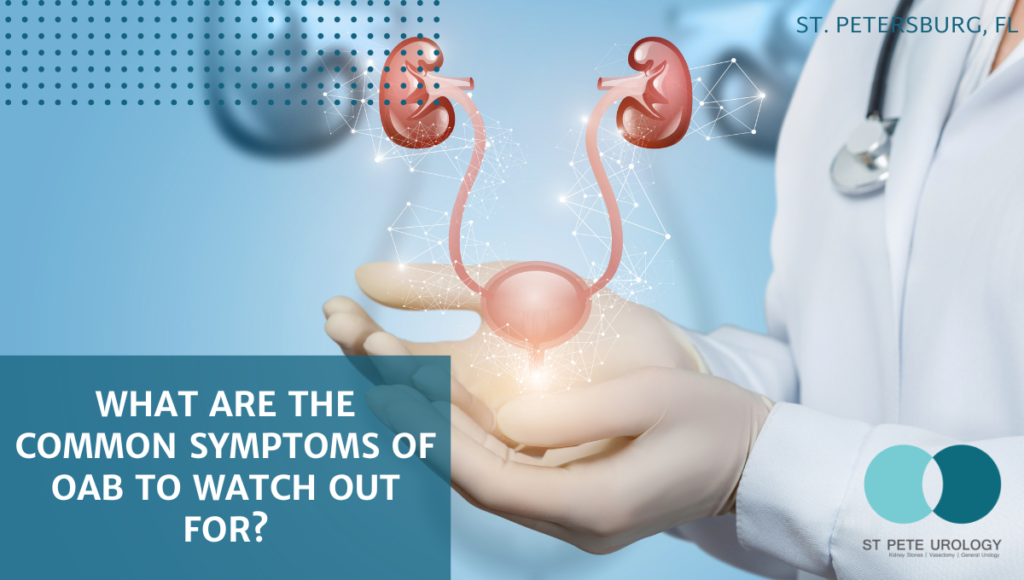
Recognizing the Symptoms of OAB
A symptom that’s virtually synonymous with an overactive bladder is frequent urination. This means needing to use the bathroom more than eight times within a 24-hour span. Root causes could be as diverse as high fluid intake, urinary tract infections, or an underlying medical condition. Regardless of the cause, the effect on a person’s life can be significant, leading to social embarrassment, anxiety, and disrupted daily routines.
The urgency to urinate, another cardinal sign of OAB, is an instantaneous, overwhelming impulse to pass urine. This can be triggered by something as simple as the sound of running water or arriving home. The key to managing this symptom lies in techniques like bladder training, which include creating a urination schedule and practicing delay techniques.
Another OAB symptom, nocturia, is defined as the need to wake up multiple times at night to urinate. Causes can range from excessive fluid intake before bedtime, to more serious issues like diabetes or prostate problems. This not only disrupts sleep patterns but can significantly impair a person’s overall quality of life.
The final symptom, urge incontinence, refers to the involuntary loss of urine immediately following the intense desire to urinate. Factors contributing to this can be conditions that affect nerve signals controlling bladder function. Thankfully, various treatment options exist, from pelvic floor exercises to medications and even surgical interventions.
Diagnosis and Treatment of OAB
Diagnosis typically begins with a thorough medical history and physical examination. Diagnostic tests include urinalysis, urodynamic testing, and in some cases, cystoscopy.
When it comes to treatment and management, behavioral changes such as bladder training, limiting fluid intake, and avoiding bladder irritants are usually the first line of action. Medications can also be employed to manage the symptoms. For more severe cases, neuromodulation and electrical stimulation are options to explore. And as a last resort, surgical interventions may be considered.
Seeking Medical Attention for OAB
While these symptoms may seem daunting, it’s essential to remember that relief is not out of reach. Be vigilant for red flags like blood in the urine, or symptoms that interfere with your daily life. A qualified Urologist can guide you on this health journey, ensuring a prompt and accurate diagnosis and an effective, personalized treatment plan.
It’s with this understanding of overactive bladder and its symptoms that you can take control of your health. Here in St. Petersburg, FL, ‘St Pete Urology‘ is a trusted provider of comprehensive urologic care. We take pride in guiding our patients through the often complex world of urologic health and strive for the best possible outcomes. Reach out to us today, and let’s work together towards achieving optimal urologic health.
References:
St Pete Urology. (2017, November 29). What is Overactive Bladder? St Pete Urology. https://stpeteurology.com/what-overactive-bladder/
St Pete Urology. (2023, March 7). St. Pete Urology | Urologists in St Petersburg, Florida. St Pete Urology. https://stpeteurology.com/what-causes-overactive-bladder-understanding-the-triggers/
- and, D. (2023, August 7). Bladder Control Problems (Urinary Incontinence) – NIDDK. National Institute of Diabetes and Digestive and Kidney Diseases. https://www.niddk.nih.gov/health-information/urologic-diseases/bladder-control-problems
- What Is Overactive Bladder (OAB)? – National Association For Continence. (2023, July 12). National Association for Continence. https://nafc.org/overactive-bladder/
- Urinalysis (urine test). (2016, August 8). National Kidney Foundation; https://www.kidney.org/atoz/content/what-urinalysis
- and, D. (2023, August 7). Urodynamic Testing. National Institute of Diabetes and Digestive and Kidney Diseases; NIDDK – National Institute of Diabetes and Digestive and Kidney Diseases. https://www.niddk.nih.gov/health-information/diagnostic-tests/urodynamic-testing
- NHS Choices. (2023). Overview – Cystoscopy. https://www.nhs.uk/conditions/cystoscopy/#:~:text=A%20cystoscopy%20is%20a%20procedure,or%20nurse%20to%20see%20inside.
Addressing Overactive Bladder in Men and Women with St. Pete Urology
Key Takeaways:
- Overactive bladder is a common condition affecting both men and women.
- There is a stigma surrounding overactive bladder that deters individuals from seeking treatment.
- St. Pete Urology is a medical practice that offers treatments to alleviate the discomfort of overactive bladder and improve patients’ quality of life.
Understanding the Overactive Bladder Predicament
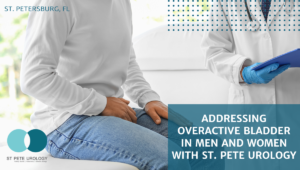 Consider this: Your plans, whether you’re attending social gatherings or even mundane tasks such as grocery shopping, are dictated by the proximity of a restroom. An overactive bladder, a common condition affecting both sexes, has made you its hostage. As summarized by Dr. Nicholas Laryngakis, a board-certified Urologist with St. Pete Urology in St. Petersburg, FL, “the bladder becomes more sensitive and reflexive as we age, leading to some people having a lot of frequency and urgency and even leakage of urine called incontinence.” This not only hampers your physical comfort but also drastically alters your quality of life.
Consider this: Your plans, whether you’re attending social gatherings or even mundane tasks such as grocery shopping, are dictated by the proximity of a restroom. An overactive bladder, a common condition affecting both sexes, has made you its hostage. As summarized by Dr. Nicholas Laryngakis, a board-certified Urologist with St. Pete Urology in St. Petersburg, FL, “the bladder becomes more sensitive and reflexive as we age, leading to some people having a lot of frequency and urgency and even leakage of urine called incontinence.” This not only hampers your physical comfort but also drastically alters your quality of life.
Men and Women: Equally Affected
This condition is not exclusive to women, as is often mistakenly assumed. Men too are victims of it. This false narrative that “women are the only ones that lose bladder control as they age” needs to be rectified. Men may need to undergo further evaluations to ensure that a prostate issue isn’t at the root of their condition.
The Stigma Around Overactive Bladder
This is a condition that often stays unaddressed due to the sensitivity and stigma surrounding it. Many people live in discomfort, limited by their ailment as they are deterred from seeking treatment. According to Dr. Laryngakis, “A lot of people are concerned and it is a sensitive area so they don’t always seek treatment…”. What is crucial in this context is the creation of a safe and confidential environment that allows individuals to comfortably discuss their predicament.
How St. Pete Urology Can Help
At St. Pete Urology, a compassionate team of professionals led by a board-certified Urologist, Dr. Laryngakis, works tirelessly to help patients regain control of their lives. The medical team prides itself on having open and confidential conversations with patients, aiming to soothe their apprehensions and create a space where they can freely express their concerns.
In the quest of addressing overactive bladder, you’re no longer alone. With an array of treatments available, St. Pete Urology aims to alleviate your discomfort, ensuring that you no longer feel the need for constant reassurance like the use of a pad or diaper.
St. Pete Urology, based in St. Petersburg, FL, is not just a medical practice. They are your allies in combating the challenges that come with an overactive bladder. In their efforts to improve patients’ quality of life, they strive to create an environment where patients feel comfortable discussing their intimate medical issues. So, break free from the burden of an overactive bladder and regain the freedom to live your life fully. Reach out to St. Pete Urology today — your journey towards a healthier, happier, and more confident you begins here.
References:
- St Pete Urology. (2013, March 28). An Overactive Bladder Overview | St Pete Urology. St Pete Urology. https://stpeteurology.com/what-is-overactive-bladder/
- Elad Leron, Weintraub, A. Y., Salvatore Andrea Mastrolia, & Schwarzman, P. (2018). Overactive Bladder Syndrome: Evaluation and Management. 11(3), 117–125. https://doi.org/10.1159/000447205
- Overactive bladder – Diagnosis and treatment – Mayo Clinic. (2022). Mayoclinic.org; https://www.mayoclinic.org/diseases-conditions/overactive-bladder/diagnosis-treatment/drc-20355721
- Overactive Bladder. (2016). Medlineplus.gov; National Library of Medicine. https://medlineplus.gov/overactivebladder.html
Transcription:
Hi, I’m Dr. Nicholas Laryngakis, board certified urologist with St. Pete Urology. Inflammatory bladder is a very common disease process that occurs to both men and women. So as we age, often the bladder becomes more sensitive and reflexive, leading to some people having a lot of frequency and urgency and even leakage of urine called incontinence. And that really affects their quality of life because they’re always having to go to the bathroom and don’t feel comfortable going out into the world without some sort of reassurance such as a pad or a diaper even unfortunately in some people. So there is a lot of treatments we have to help patients with that. A lot of people are concerned and it is a sensitive area so they don’t always seek treatment but here at St. Pete Urology, we’re very open with patients, we have confidential conversations and try to help them with these kind of problems. That women are the only ones that lose bladder control as they age but it can occur in men. Often men have to be evaluated a little further to make sure it’s not a prostate issue.
What is Overactive Bladder?
It is easy to guess what the term “Overactive Bladder” means. The bladder is generally associated with the containment of urine until it is passed out of the body. An overactive bladder results in the frequent, involuntary or unexpected release of urine and can cause someone to avoid social interactions they would normally have enjoyed.

